Design and Verification of a Dry Sensor-Based Multi-Channel Digital Active Circuit for Human Brain Electroencephalography Signal Acquisition Systems
Abstract
1. Introduction
2. Materials and Methods
2.1. Disposable Dry EEG sensors
2.2. Active Circuit
2.3. Electroencephalography (EEG) Signal Processing Module
2.4. Flexible Printed Circuit Board
2.5. Experiments for Verification
3. Results and Discussion
3.1. Eye Blinking and Teeth Gritting
3.2. Eyes-Open/Eyes-Closed States
3.3. Event-Related Potentials
4. Conclusions
Author Contributions
Acknowledgments
Conflicts of Interest
References
- Wu, S.-L.; Liao, L.-D.; Liou, C.-H.; Chen, S.-A.; Ko, L.-W.; Chen, B.-W.; Wang, P.-S.; Chen, S.-F.; Lin, C.-T.; Chen, B.-W.; et al. Design of the multi-channel electroencephalography-based brain-computer interface with novel dry sensors. In Proceedings of the 2012 Annual International Conference of the IEEE Engineering in Medicine and Biology Society (EMBC), San Diego, CA, USA, 28 August–1 September 2012; pp. 1793–1797. [Google Scholar]
- Vaughan, T.M.; McFarland, D.J.; Schalk, G.; Sarnacki, W.A.; Krusienski, D.J.; Sellers, E.W.; Wolpaw, J.R. The Wadsworth BCI research and development program: At home with BCI. IEEE Trans. Neur. Syst. Rehabil. Eng. 2006, 14, 229–233. [Google Scholar] [CrossRef] [PubMed]
- Teplan, M. Fundamentals of EEG measurement. Meas. Sci. Rev. 2002, 2, 1–11. [Google Scholar]
- Lance, B.J.; Kerick, S.E.; Ries, A.J.; Oie, K.S.; McDowell, K. Brain-Computer Interface Technologies in the Coming Decades. Proc. IEEE 2012, 100, 1585–1599. [Google Scholar] [CrossRef]
- Liao, L.-D.; Chen, C.-Y.; Wang, I.-J.; Chen, S.-F.; Li, S.-Y.; Chen, B.-W.; Chang, J.-Y.; Lin, C.-T. Gaming control using a wearable and wireless EEG-based brain-computer interface device with novel dry foam-based sensors. J. Neuroeng. Rehab. 2012, 9, 5. [Google Scholar] [CrossRef]
- Gao, X.; Xu, D.; Cheng, M.; Gao, S. A BCI-based environmental controller for the motion-disabled. IEEE Trans. Neur. Syst. Rehabil. Eng. 2003, 11, 137–140. [Google Scholar]
- Royer, A.S.; Doud, A.J.; Rose, M.L.; He, B. EEG control of a virtual helicopter in 3-dimensional space using intelligent control strategies. IEEE Trans. Neur. Syst. Rehabil. Eng. 2010, 18, 581–589. [Google Scholar] [CrossRef]
- Rebsamen, B.; Guan, C.; Zhang, H.; Wang, C.; Teo, C.; Ang, M.H., Jr.; Burdet, E. A Brain Controlled Wheelchair to Navigate in Familiar Environments. IEEE Trans. Neur. Syst. Rehabil. Eng. 2010, 18, 590–598. [Google Scholar] [CrossRef]
- Zhang, H.; Guan, C.; Wang, C. Asynchronous P300-based brain--computer interfaces: A computational approach with statistical models. IEEE Trans. Biomed. Eng. 2008, 55, 1754–1763. [Google Scholar] [CrossRef]
- Hoffmann, U.; Vesin, J.-M.; Ebrahimi, T.; Diserens, K. An efficient P300-based brain–computer interface for disabled subjects. J. Neurosci. Methods 2008, 167, 115–125. [Google Scholar] [CrossRef]
- Chen, W.-D.; Zhang, J.-H.; Zhang, J.-C.; Li, Y.; Qi, Y.; Su, Y.; Wu, B.; Zhang, S.-M.; Dai, J.-H.; Zheng, X.-X. A P300 based online brain-computer interface system for virtual hand control. J. Zhejiang Univ. Sci. C 2010, 11, 587–597. [Google Scholar] [CrossRef]
- Mugler, E.M.; Ruf, C.A.; Halder, S.; Bensch, M.; Kubler, A. Design and implementation of a P300-based brain-computer interface for controlling an internet browser. IEEE Trans. Neur. Syst. Rehabil. Eng. 2010, 18, 599–609. [Google Scholar] [CrossRef] [PubMed]
- Casson, A.J. Wearable EEG and beyond. Biomed. Eng. Lett. 2019, 9, 53–71. [Google Scholar] [CrossRef] [PubMed]
- Lin, C.-T.; Ko, L.-W.; Chiou, J.-C.; Duann, J.-R.; Huang, R.-S.; Liang, S.-F.; Chiu, T.-W.; Jung, T.-P. Noninvasive neural prostheses using mobile and wireless EEG. Proc. IEEE 2008, 96, 1167–1183. [Google Scholar]
- Liao, L.D.; Lin, C.T.; McDowell, K.; Wickenden, A.E.; Gramann, K.; Jung, T.P.; Ko, L.-W.; Chang, J.-Y. Biosensor technologies for augmented brain-computer interfaces in the next decades. Proce. IEEE 2012, 100, 1553–1566. [Google Scholar] [CrossRef]
- Xu, J.; Yazicioglu, R.F.; Harpe, P.; Makinwa, K.A.; Van Hoof, C. A 160 μW 8-channel active electrode system for EEG monitoring. In Proceedings of the 2011 IEEE International on Solid-State Circuits Conference Digest of Technical Papers (ISSCC), San Francisco, CA, USA, 20–24 February 2011; pp. 300–302. [Google Scholar]
- Liao, L.D.; Wang, I.J.; Chen, S.F.; Chang, J.Y.; Lin, C.T. Design, Fabrication and Experimental Validation of a Novel Dry-Contact Sensor for Measuring Electroencephalography Signals without Skin Preparation. Sensors 2011, 11, 5819–5834. [Google Scholar] [CrossRef] [PubMed]
- Mullen, T.R.; Kothe, C.A.E.; Chi, Y.M.; Ojeda, A.; Kerth, T.; Makeig, S.; Jung, T.-P.; Cauwenberghs, G. Real-Time Neuroimaging and Cognitive Monitoring Using Wearable Dry EEG. IEEE Trans. Biomed. Eng. 2015, 62, 2553–2567. [Google Scholar] [CrossRef]
- O’Sullivan, M.; Temko, A.; Bocchino, A.; O’Mahony, C.; Boylan, G.; Popovici, E. Analysis of a Low-Cost EEG Monitoring System and Dry Electrodes toward Clinical Use in the Neonatal ICU. Sensors 2019, 19, 2637. [Google Scholar] [CrossRef]
- Binnie, C.D.; Rowan, A.J.; Gutter, T. A Manual of Electroencephalographic Technology; CUP Archive: Cambridge, UK, 1982. [Google Scholar]
- Webster, J.G. Medical Instrumentation: Application and Design, 3rd ed.; John Wiley & Sons Inc.: Hoboken, NJ, USA, 1998. [Google Scholar]
- Sadeh, B.; Podlipsky, I.; Zhdanov, A.; Yovel, G. Event-related potential and functional MRI measures of face-selectivity are highly correlated: A simultaneous ERP-fMRI investigation. Hum. Brain Mapp. 2010, 31, 1490–1501. [Google Scholar] [CrossRef]
- Beckmann, L.; Neuhaus, C.; Medrano, G.; Jungbecker, N.; Walter, M.; Gries, T.; Leonhardt, S. Characterization of textile electrodes and conductors using standardized measurement setups. Physiol. Measur. 2010, 31, 233–247. [Google Scholar] [CrossRef]
- Thakor, N.V. Translating the brain-machine interface. Sci. Transl. Med. 2013, 5, 210ps17. [Google Scholar] [CrossRef]
- Makeig, S.; Kothe, C.; Mullen, T.; Bigdely-Shamlo, N.; Zhang, Z.; Kreutz-Delgado, K. Evolving Signal Processing for Brain-Computer Interfaces. Proc. IEEE 2012, 100, 1567–1584. [Google Scholar] [CrossRef]
- Ferree, T.C.; Luu, P.; Russell, G.S.; Tucker, D.M. Scalp electrode impedance, infection risk, and EEG data quality. Clin. Neurophysiol. 2001, 112, 536–544. [Google Scholar] [CrossRef]
- Lin, C.T.; Liao, L.D.; Liu, Y.H.; Wang, I.J.; Lin, B.S.; Chang, J.Y. Novel Dry Polymer Foam Electrodes for Long-Term EEG Measurement. IEEE Trans. Biomed. Eng. 2011, 58, 1200–1207. [Google Scholar] [PubMed]
- Qiang, J.; Zhiwei, Z.; Lan, P. Real-time nonintrusive monitoring and prediction of driver fatigue. IEEE Trans. Vehic. Technol. 2004, 53, 1052–1068. [Google Scholar]
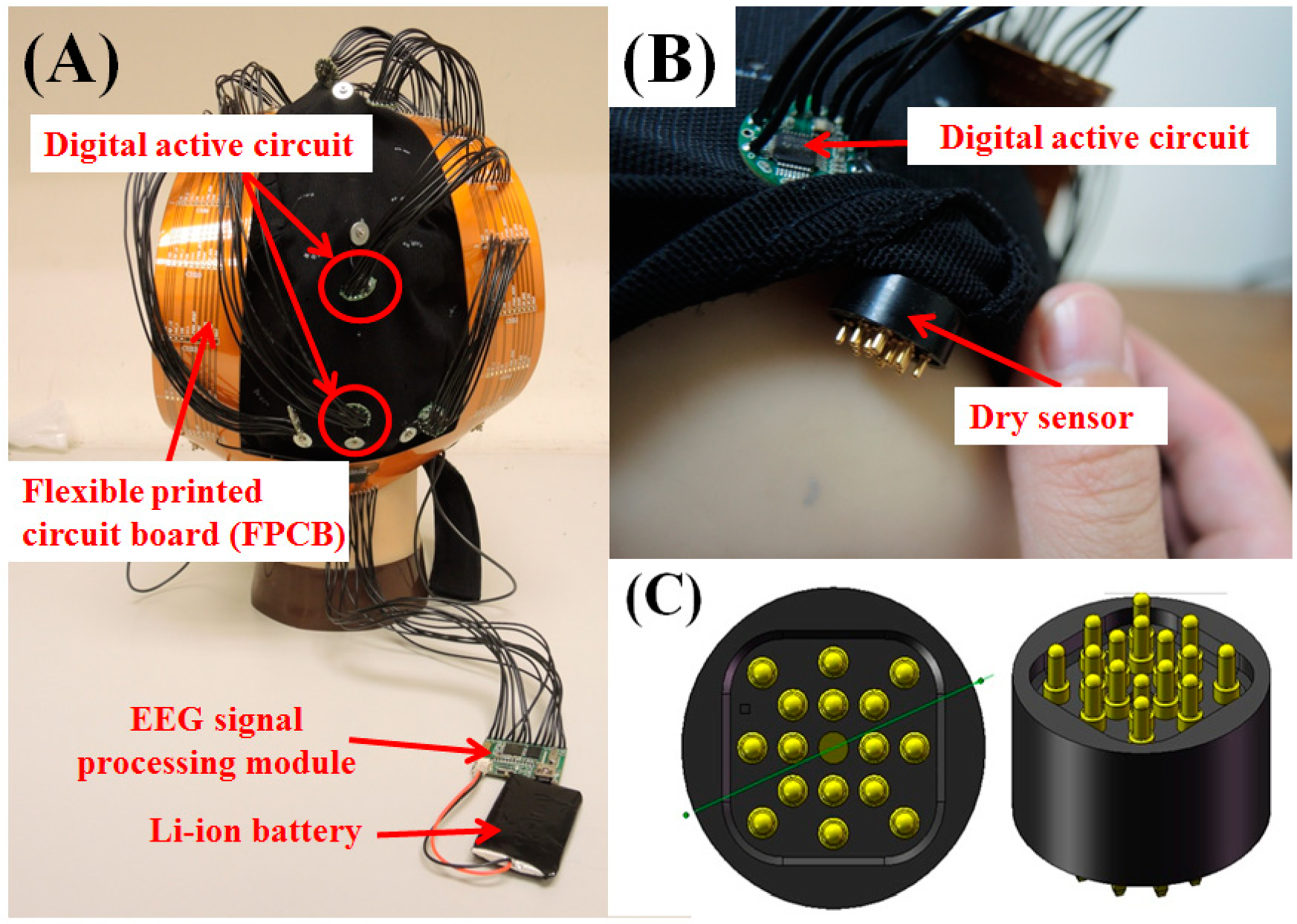
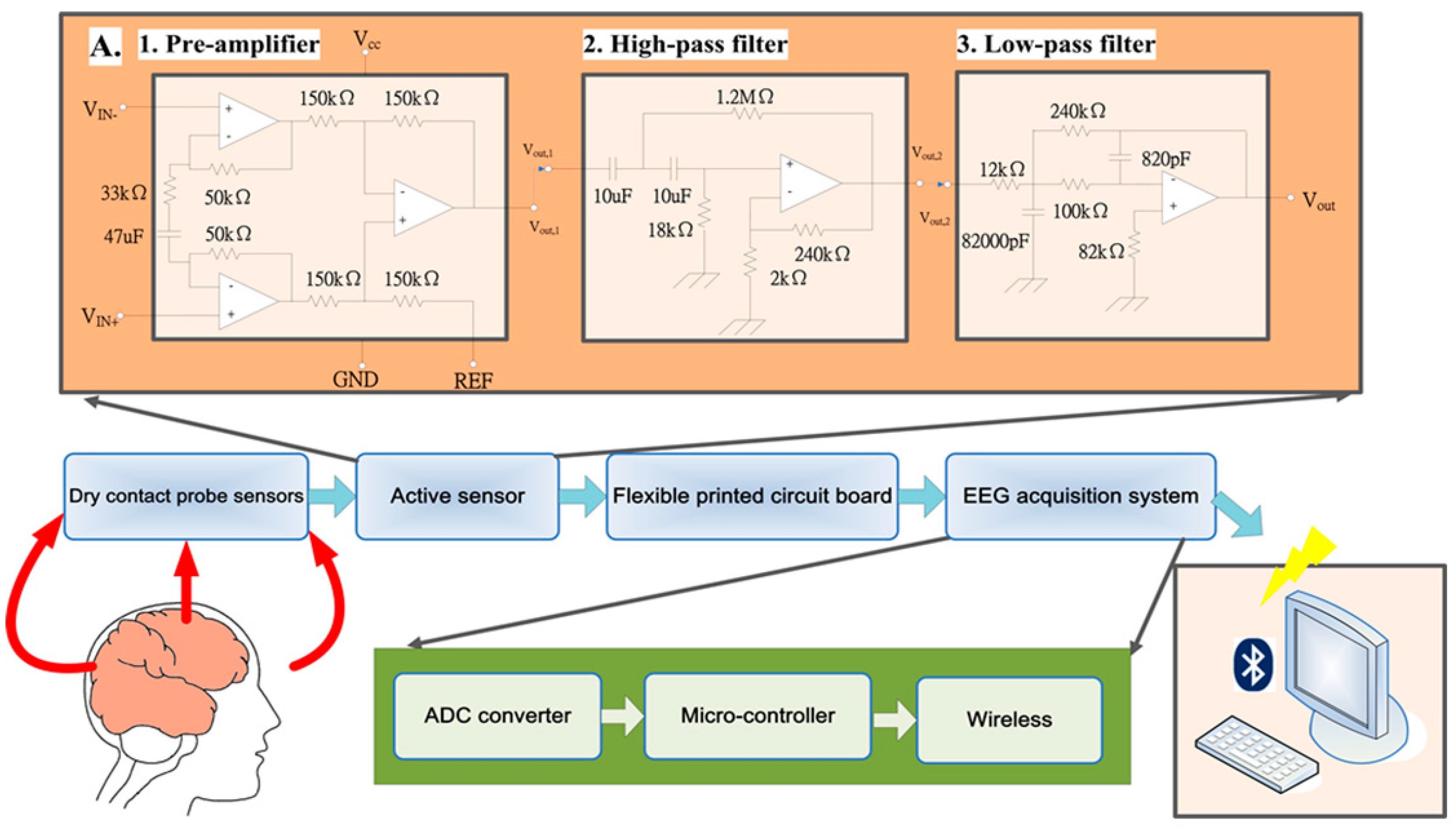
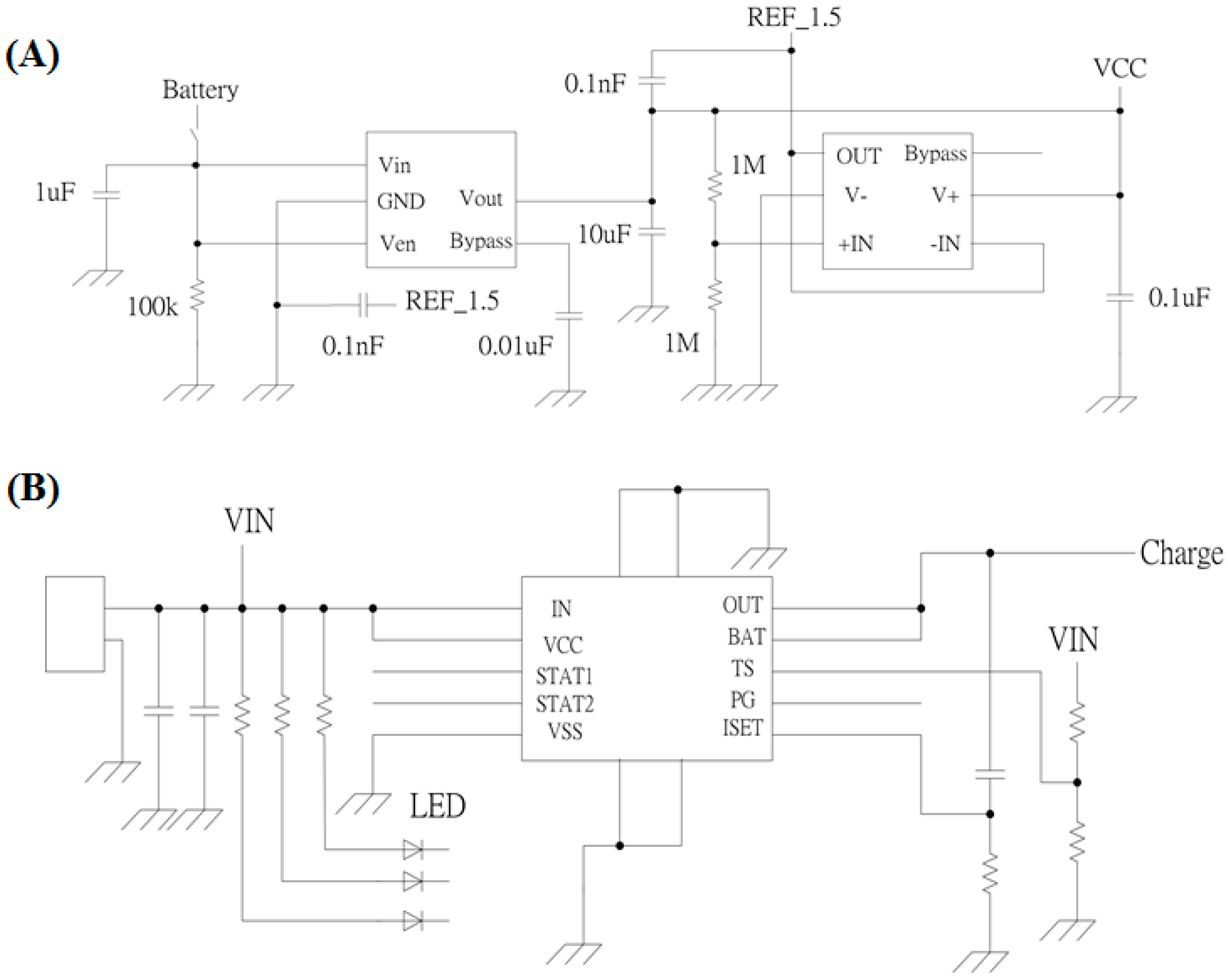
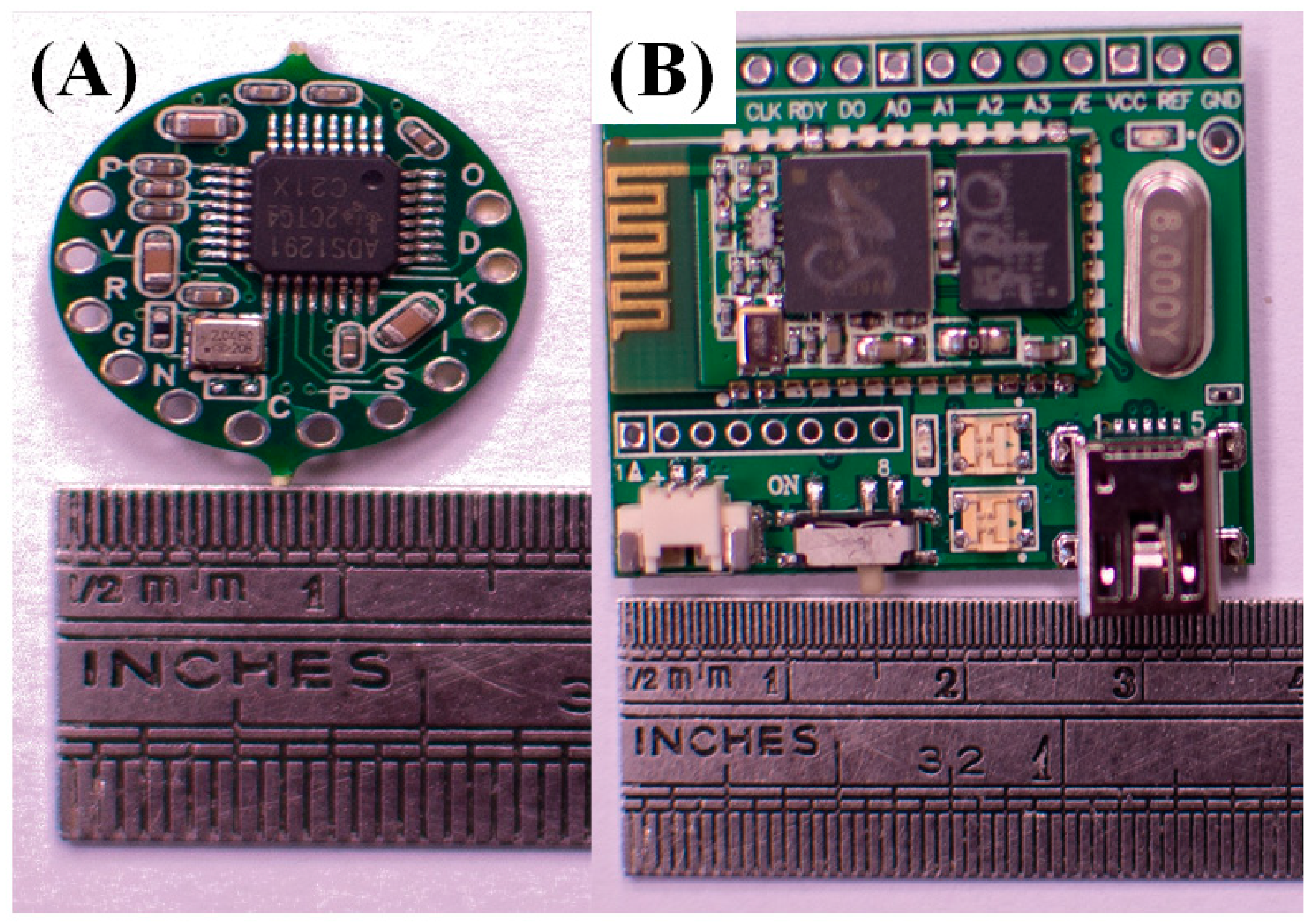
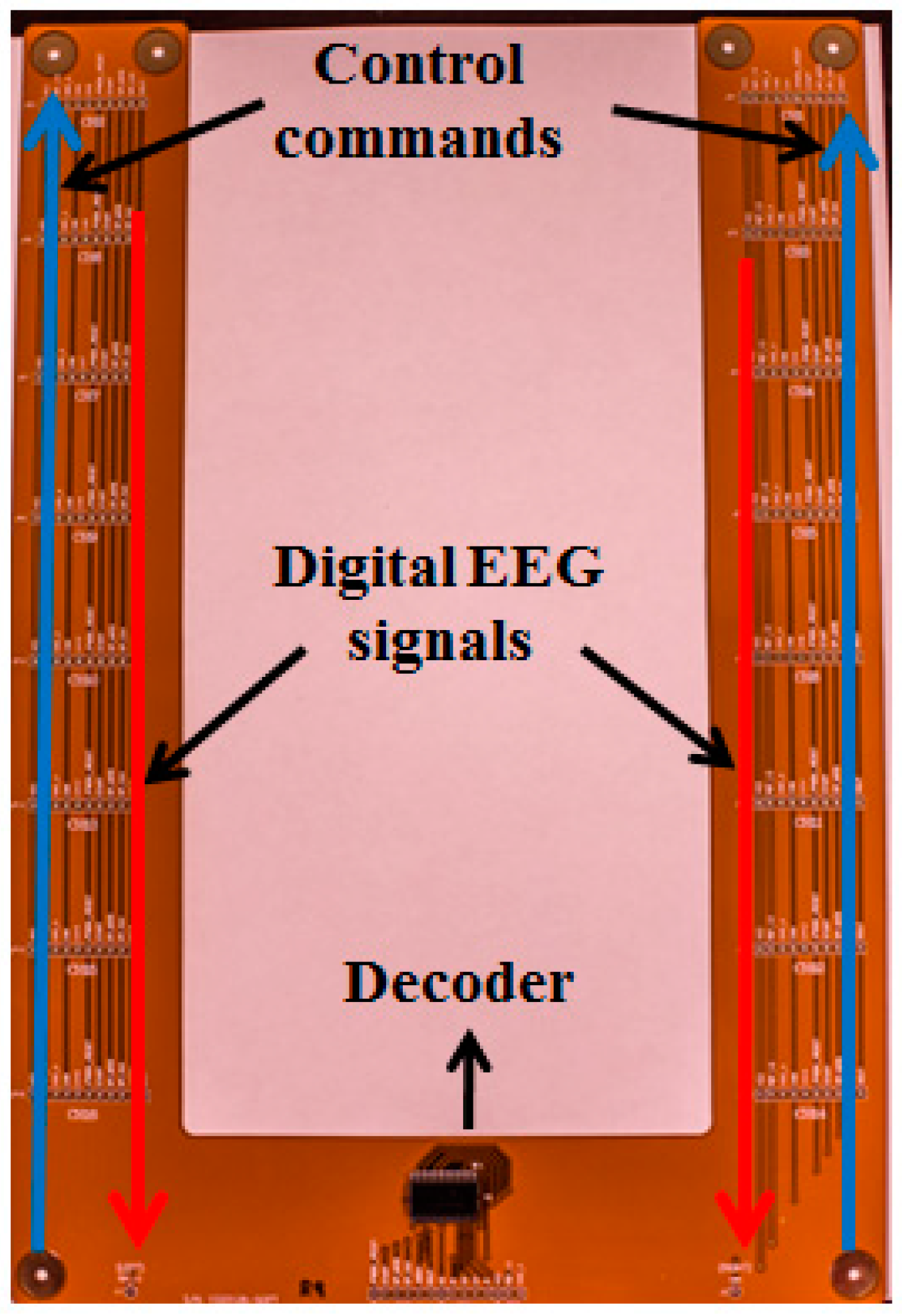
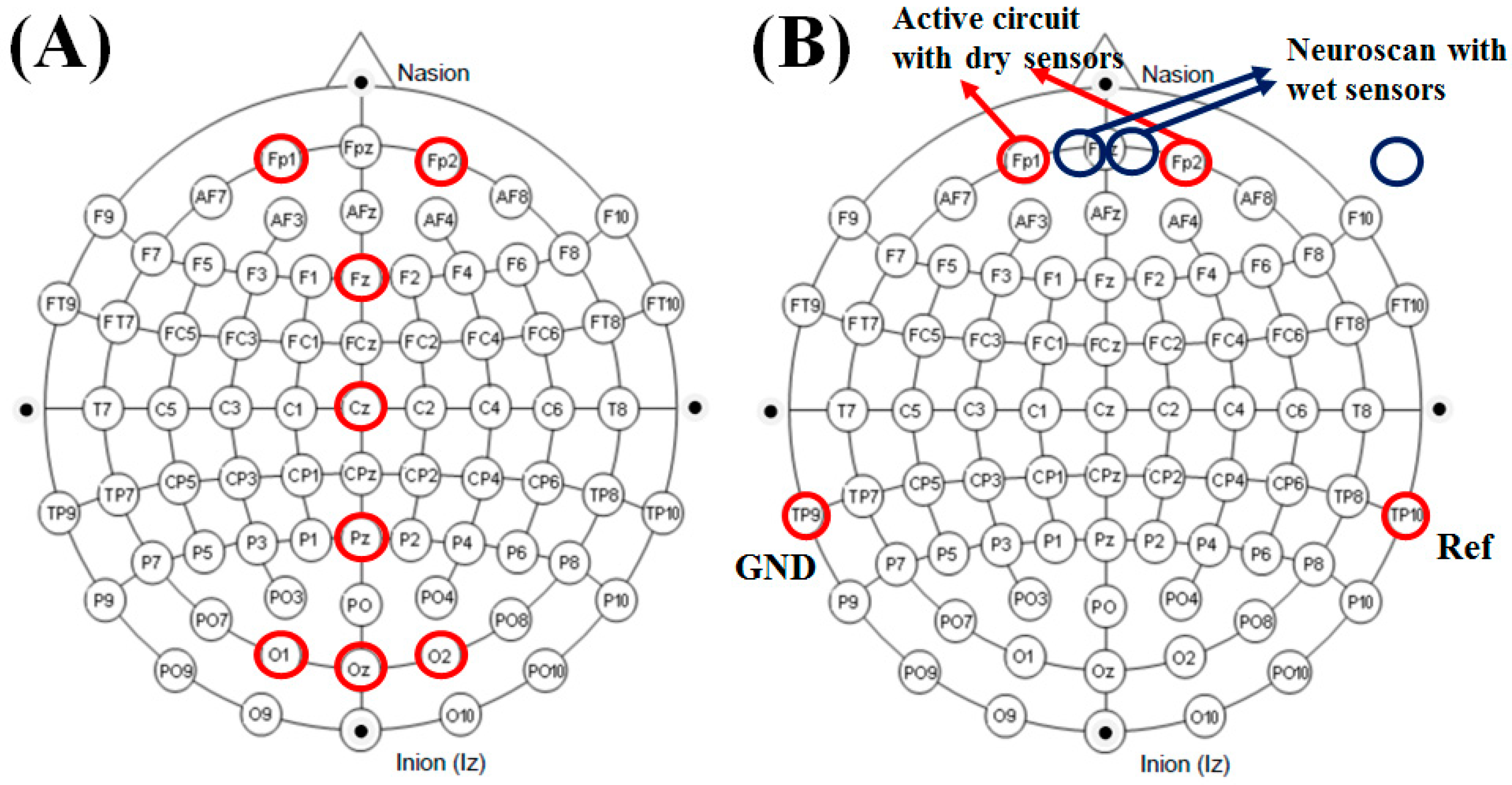
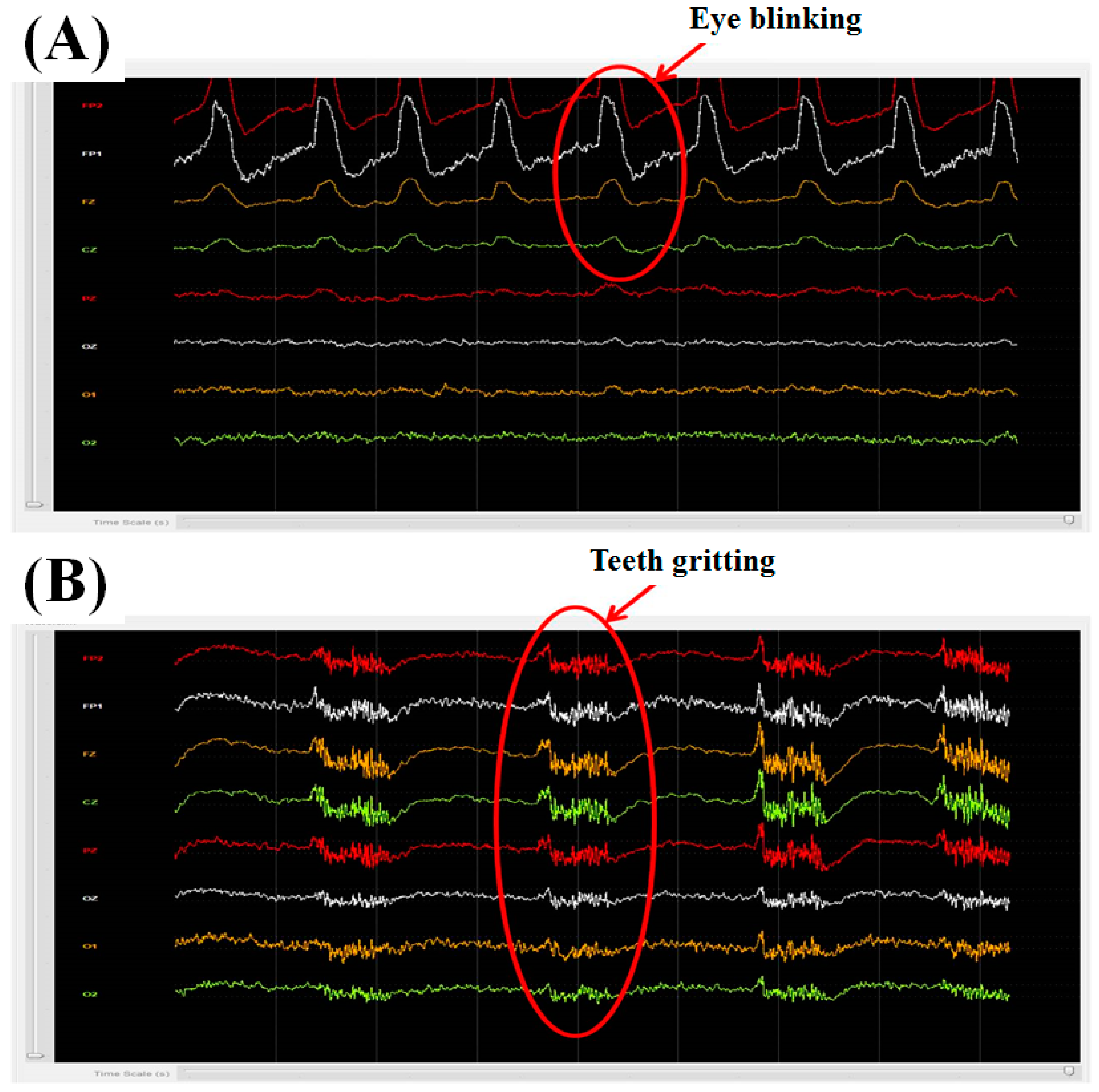
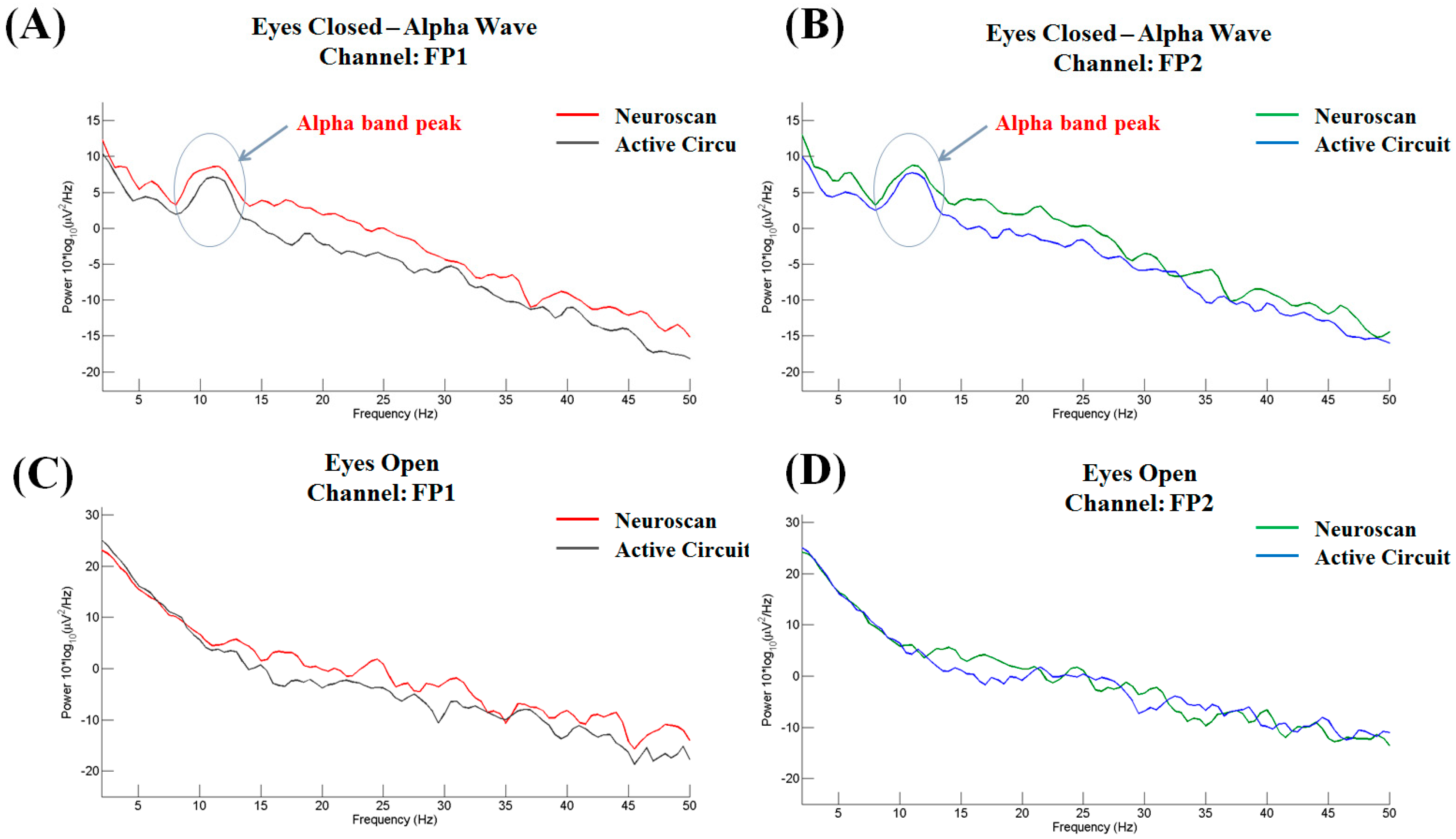
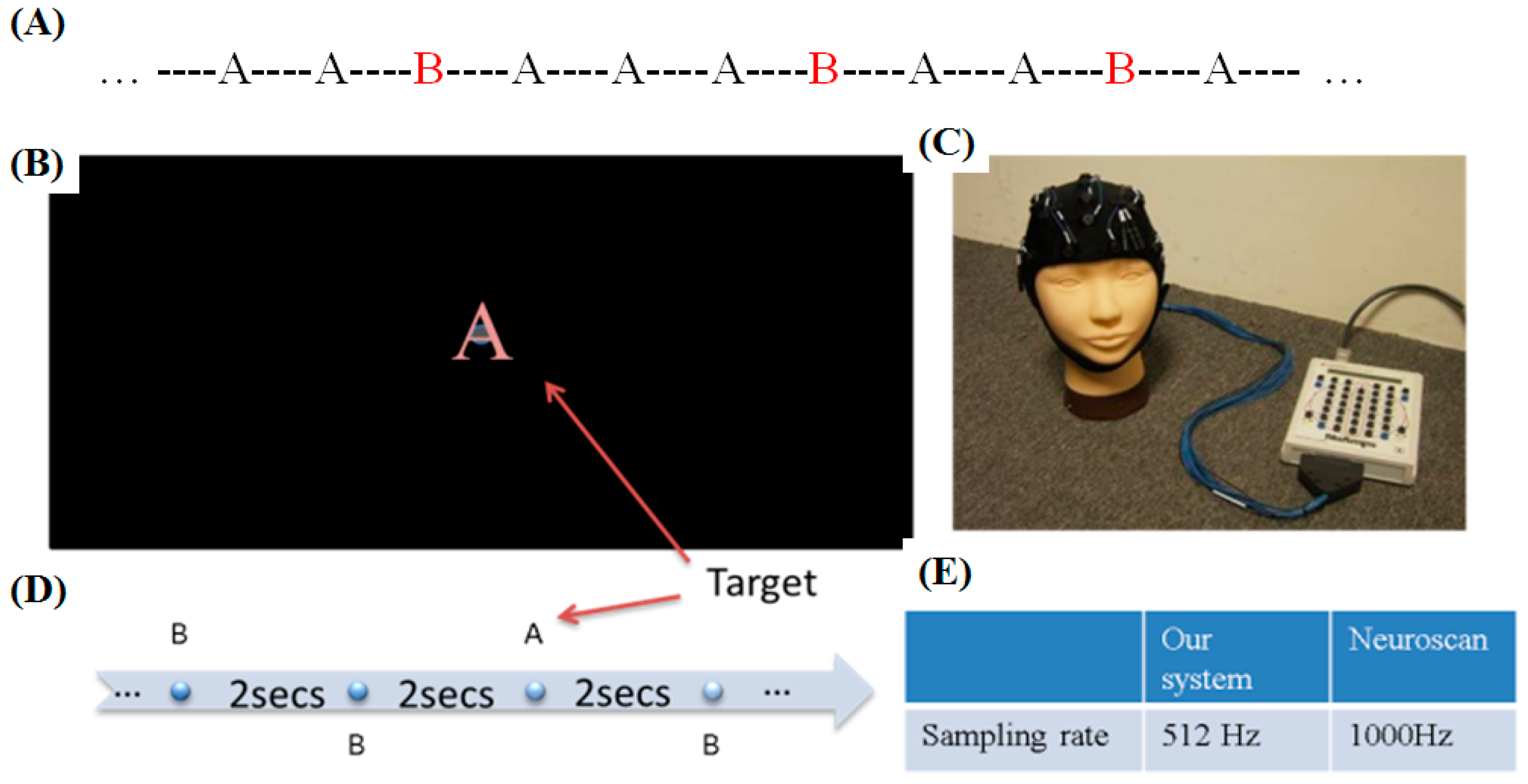
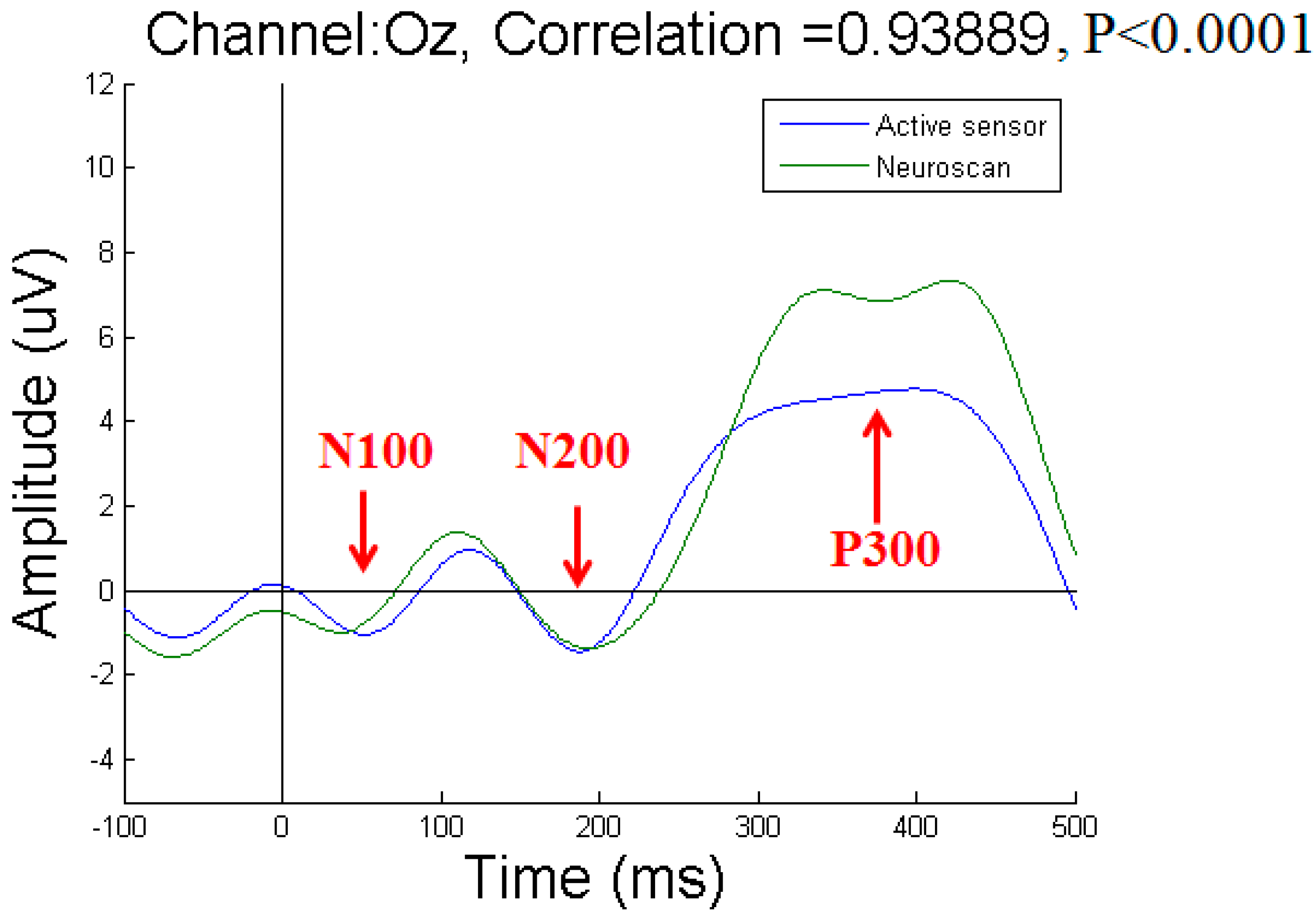
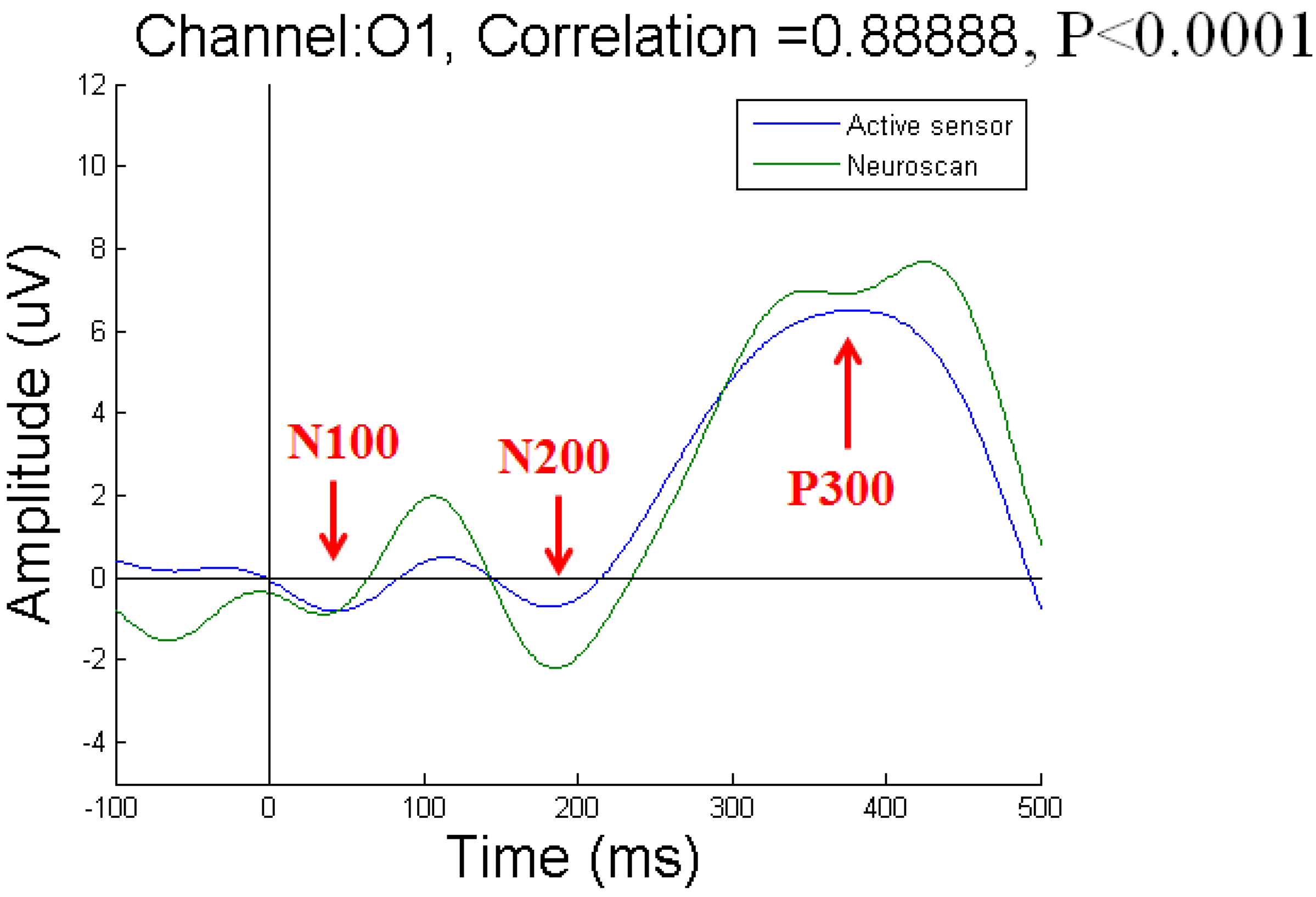
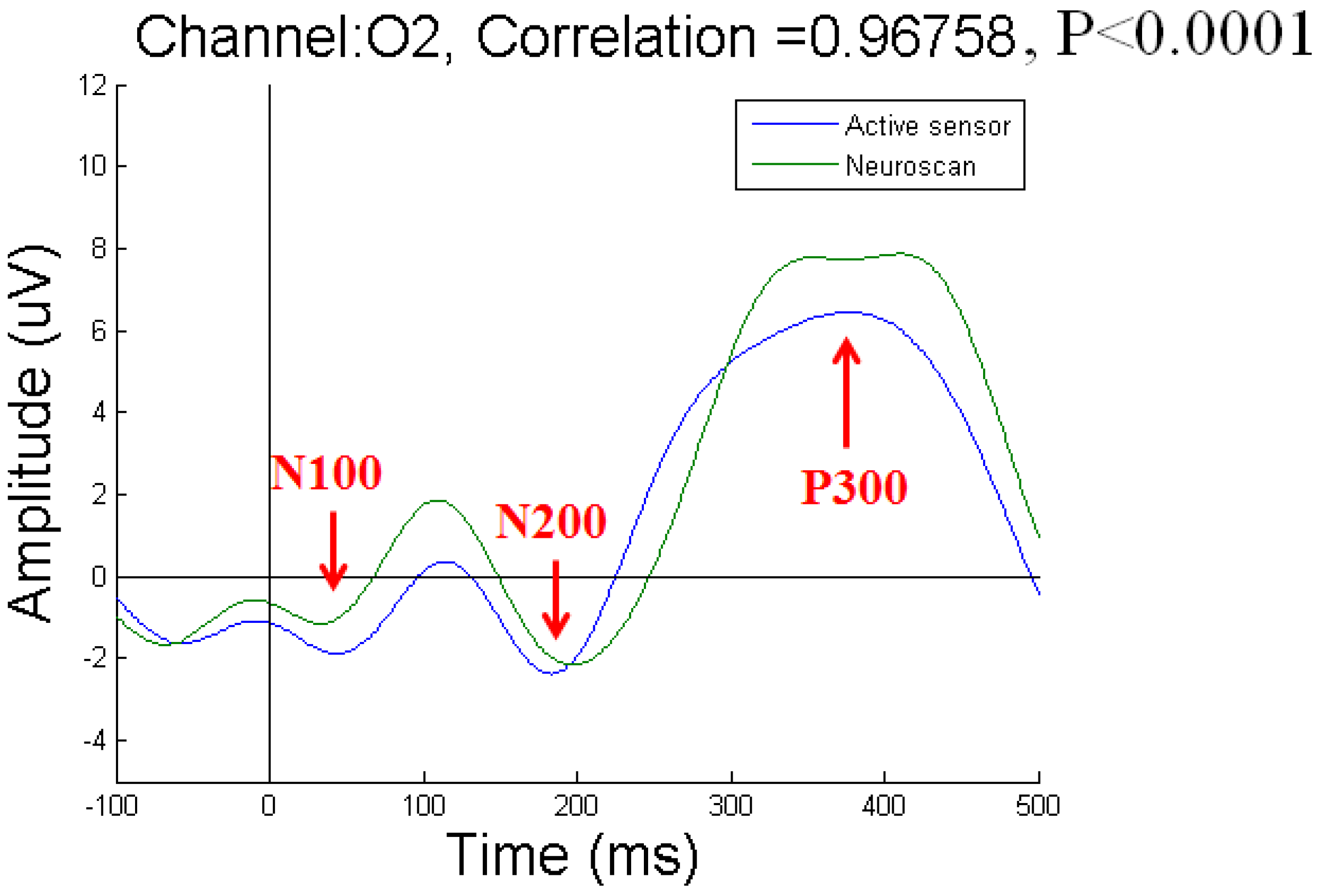
| Specification | Active-Circuit EEG Signal Acquisition System |
|---|---|
| Channel Number | 8 |
| System Voltage Supply | 3 V |
| Gain | 9752 V/V |
| Bandwidth | 0.103~128 Hz |
| ADC Resolution | 24 bits |
| Output Current | 33 mA |
| Battery | Lithium 3.7 V; 650 mAh (20+ h) |
| ADC Sampling Rate | 512 Hz |
| Size: Active Circuit + EEG Signal Processing Module | Circular (16 mm diameter) + Rectangular (36 mm × 28 mm) |
© 2019 by the authors. Licensee MDPI, Basel, Switzerland. This article is an open access article distributed under the terms and conditions of the Creative Commons Attribution (CC BY) license (http://creativecommons.org/licenses/by/4.0/).
Share and Cite
Lin, C.-T.; Liu, C.-H.; Wang, P.-S.; King, J.-T.; Liao, L.-D. Design and Verification of a Dry Sensor-Based Multi-Channel Digital Active Circuit for Human Brain Electroencephalography Signal Acquisition Systems. Micromachines 2019, 10, 720. https://doi.org/10.3390/mi10110720
Lin C-T, Liu C-H, Wang P-S, King J-T, Liao L-D. Design and Verification of a Dry Sensor-Based Multi-Channel Digital Active Circuit for Human Brain Electroencephalography Signal Acquisition Systems. Micromachines. 2019; 10(11):720. https://doi.org/10.3390/mi10110720
Chicago/Turabian StyleLin, Chin-Teng, Chi-Hsien Liu, Po-Sheng Wang, Jung-Tai King, and Lun-De Liao. 2019. "Design and Verification of a Dry Sensor-Based Multi-Channel Digital Active Circuit for Human Brain Electroencephalography Signal Acquisition Systems" Micromachines 10, no. 11: 720. https://doi.org/10.3390/mi10110720
APA StyleLin, C.-T., Liu, C.-H., Wang, P.-S., King, J.-T., & Liao, L.-D. (2019). Design and Verification of a Dry Sensor-Based Multi-Channel Digital Active Circuit for Human Brain Electroencephalography Signal Acquisition Systems. Micromachines, 10(11), 720. https://doi.org/10.3390/mi10110720






